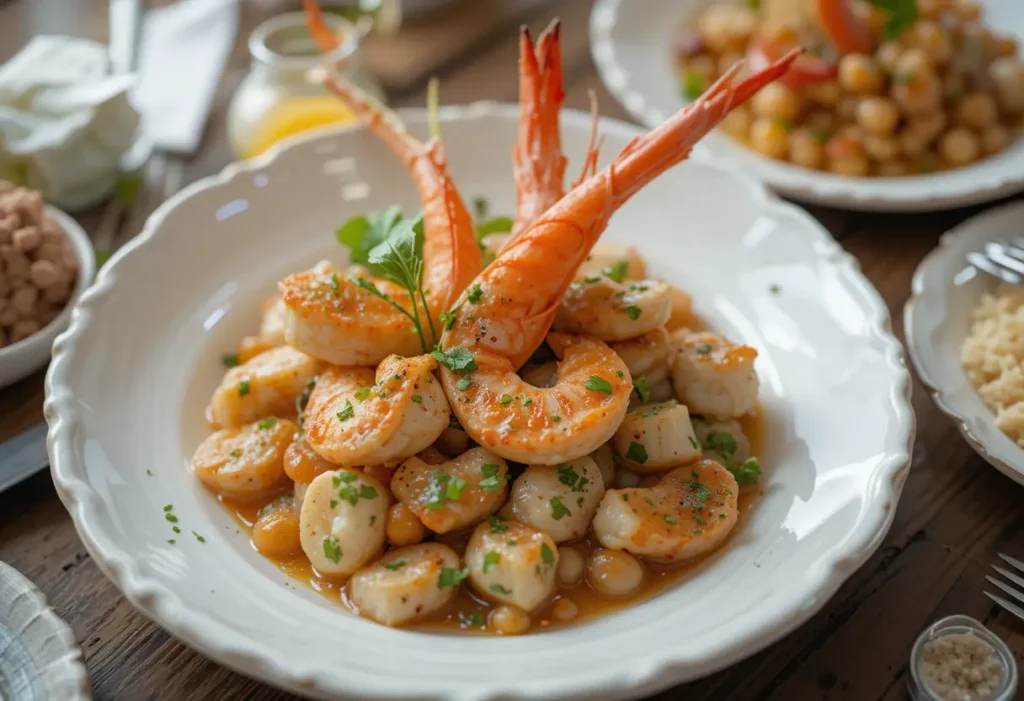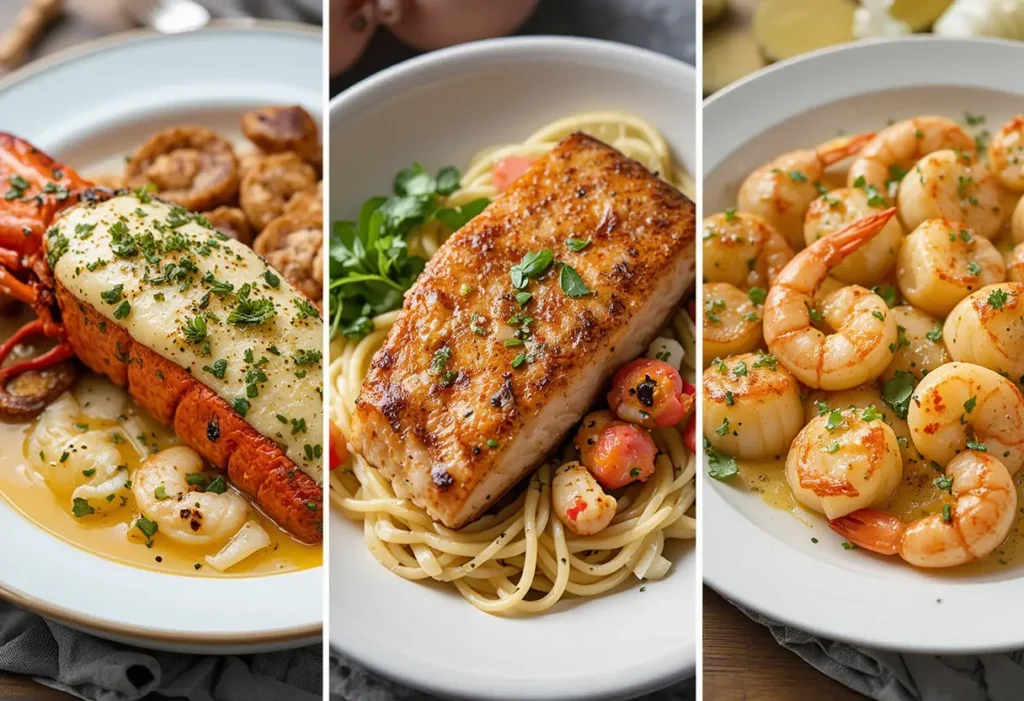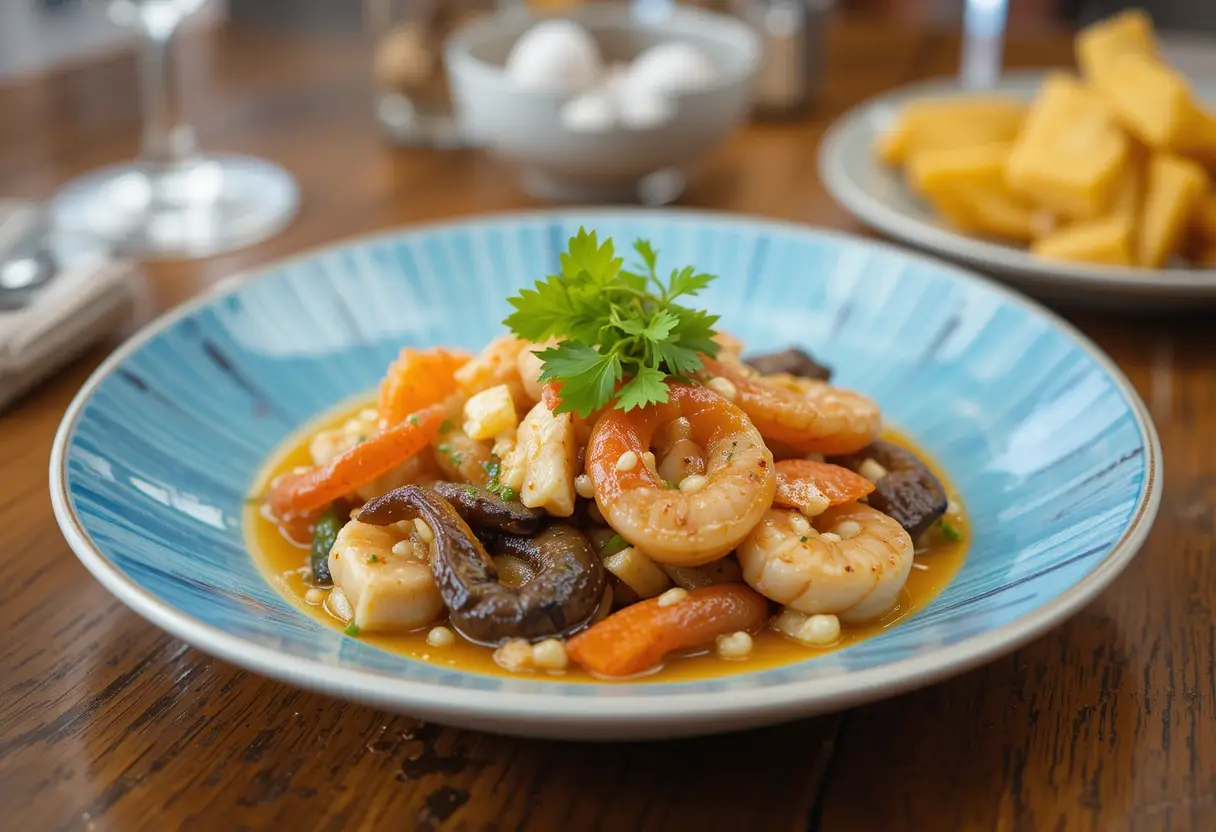Seafood Delight has always been a culinary treasure, cherished by food lovers around the globe for its incredible versatility and mouthwatering flavors. From the freshness of ocean-caught fish to the succulence of shellfish, seafood takes center stage in cuisines worldwide. Whether you prefer it grilled, fried, steamed, or served raw, the unmatched taste and health benefits of seafood make it a true crowd-pleaser.

But what makes seafood such a cornerstone of our diets? For centuries, coastal communities have embraced the ocean’s bounty, crafting unique recipes that reflect their culture and surroundings. These traditional dishes have since become global favorites, celebrated for their ability to unite people through vibrant flavors and wholesome nutrition. This guide to Seafood Delight uncovers ten irresistible dishes you need to try and explores why seafood deserves a prominent place in your diet.
Table of Contents
Exploring the Varieties of Seafood
Common Types of Seafood Used in Cooking
The ocean is brimming with an astonishing variety of seafood, each offering distinct textures and flavors. Here are some common categories you’ll often find in recipes:
- Fish: Popular options include salmon, cod, tilapia, tuna, and mackerel. These are versatile and can be prepared in countless ways.
- Shellfish: Crabs, lobsters, shrimp, and scallops are renowned for their rich and luxurious taste.
- Mollusks: Think clams, mussels, oysters, and squid. These are staples in Mediterranean, Asian, and coastal cuisines.
- Exotic Varieties: Octopus, sea urchin, and even jellyfish are considered delicacies in certain parts of the world.
- Canned Seafood: Items like canned tuna, sardines, and anchovies are economical and convenient, making them household essentials.
From sushi rolls in Japan to hearty clam chowder in New England, each type of seafood lends itself to iconic dishes, satisfying cravings across cultures.
Benefits of Including Seafood in Your Diet
Seafood isn’t just a treat for the taste buds it’s also a powerhouse of nutrients. Adding seafood to your meals can offer the following health benefits:
- Rich in Omega-3 Fatty Acids: These healthy fats, especially in fatty fish like salmon and mackerel, improve heart health and reduce inflammation.
- High-Quality Protein: Seafood provides a lean, easily digestible source of protein that promotes muscle growth and repair.
- Packed with Essential Vitamins and Minerals: It’s a great source of Vitamin D, Vitamin B12, iodine, and selenium, which are vital for maintaining energy and boosting the immune system.
- Brain-Boosting Nutrients: Omega-3s also enhance brain function and are particularly beneficial for children’s cognitive development.
- Low in Calories and Saturated Fats: This makes seafood an excellent choice for weight management without compromising on flavor.
By incorporating seafood into your diet, you not only treat yourself to delightful dishes but also support overall health and well-being.
Top 10 Seafood Dishes You Must Try
Seafood is celebrated for its diversity, and these ten dishes represent some of the most iconic and beloved ways to enjoy the flavors of the ocean. Each one is unique, offering something for every palate. Let’s dive in!
Lobster Thermidor
A luxurious French dish, Lobster Thermidor is a creamy, rich seafood delicacy. The lobster meat is cooked in a mixture of egg yolks, mustard, and cream, then placed back into its shell and topped with cheese before being baked to golden perfection. Perfect for special occasions, it’s a dish that screams elegance and indulgence.
Grilled Salmon with Herb Butter
Grilled salmon is a simple yet exquisite dish that combines the smokiness of the grill with the buttery richness of salmon. When topped with herb butter, made with fresh dill, parsley, and lemon zest, it becomes a flavorful and healthy entrée, ideal for weeknight dinners or summer barbecues.
Classic Shrimp Scampi
Shrimp Scampi is a classic seafood favorite that highlights shrimp’s natural sweetness. Sautéed in garlic, olive oil, butter, and a splash of white wine, this dish is often served over pasta or with crusty bread to soak up the luscious sauce. Quick to prepare, it’s a go-to for seafood lovers.
Crab Cakes with Aioli Sauce
Crab cakes are a quintessential coastal dish, especially in the United States. Made with fresh lump crab meat, breadcrumbs, mayonnaise, and a hint of Old Bay seasoning, they’re crispy on the outside and tender on the inside. Serve them with a tangy aioli sauce for the perfect appetizer or main course.
Seared Scallops with Lemon and Garlic
Seared scallops are a restaurant-quality dish you can easily recreate at home. The key lies in achieving a perfect golden crust while keeping the inside tender and juicy. A drizzle of lemon-garlic butter sauce enhances their natural sweetness, making this dish a true crowd-pleaser.

Fish Tacos with Cilantro Lime Dressing
Fish tacos are a fun and flavorful way to enjoy seafood, blending Mexican-inspired flavors with fresh ingredients. Lightly battered or grilled fish (like cod or tilapia) is tucked into soft tortillas and topped with shredded cabbage, pico de gallo, and a zesty cilantro lime dressing. They’re vibrant, satisfying, and perfect for a casual meal.
Sushi and Sashimi Selections
Sushi and sashimi offer a taste of Japan’s culinary artistry. Whether it’s a simple salmon nigiri, a colorful California roll, or delicate slices of raw tuna sashimi, this dish showcases the beauty and freshness of raw seafood. Served with soy sauce, wasabi, and pickled ginger, it’s a must-try for adventurous eaters.
Paella Marinera
Hailing from Spain, Paella Marinera is a seafood-lover’s dream. This saffron-infused rice dish is loaded with an assortment of seafood like mussels, clams, shrimp, and squid. The bold flavors of paprika, garlic, and olive oil make this dish both hearty and unforgettable, perfect for family gatherings or celebrations.
New England Clam Chowder
A creamy and comforting soup, New England Clam Chowder is a staple of American coastal cuisine. Made with fresh clams, potatoes, onions, and celery, it’s rich, hearty, and perfect for warming up on a chilly day. A side of oyster crackers or a slice of crusty bread completes this iconic dish.
Oyster Rockefeller
Invented in New Orleans, Oyster Rockefeller is a decadent appetizer featuring oysters baked with a topping of breadcrumbs, spinach, butter, and Parmesan cheese. The dish is broiled until bubbling and golden, delivering a perfect balance of creamy, crispy, and briny flavors. It’s a must-try for oyster enthusiasts.

These ten dishes demonstrate the versatility and deliciousness of seafood, from simple preparations to indulgent culinary masterpieces. Each one is a testament to the ocean’s bounty and the creativity of chefs around the world.
How to Select and Store Seafood
Properly selecting and storing seafood is crucial to maintain its freshness, flavor, and safety. With these expert tips, you can enjoy top-quality seafood every time.
Choosing Fresh Seafood
Freshness is everything when purchasing seafood. Follow these guidelines:
Fish: Choose fish with clear, bright eyes and shiny skin. The flesh should be firm, bouncing back when pressed. Steer clear of fish with a strong odor fresh fish should smell clean and ocean-like. For ideas on cooking fresh salmon, check out our guide to popular ways to cook salmon.
Shellfish: Clams, mussels, and oysters should have tightly closed shells or close when tapped. Discard any with cracked or broken shells.
Crustaceans: When buying live crabs or lobsters, look for active and responsive specimens. For frozen options like shrimp, avoid products with ice crystals, as this signals refreezing. You can also explore recipes like our flavorful seafood enchiladas to make the most of your shellfish.
Smell Test: Seafood should smell mildly briny, like seawater. Sour or ammonia-like odors suggest spoilage.
For the best results, purchase from a trusted fishmonger or store with high turnover.
Best Practices for Seafood Storage
Correct storage is essential to maintain seafood quality and prevent spoilage:
- Refrigeration: Store fresh seafood in the coldest part of your fridge (below 40°F/4°C). Place it on a plate with ice to keep it extra cold, and consume within 1-2 days.
- Freezing: Wrap seafood tightly in plastic wrap or freezer-safe bags and freeze at 0°F (-18°C). Most seafood stays good for up to three months. Need cooking inspiration for frozen seafood? Try our pineapple chili salmon recipe.
- Shellfish Storage: Keep live shellfish in breathable containers (like mesh bags) in the fridge, covered with a damp towel. Don’t seal them in airtight bags as they need air to survive.
- Thawing: Thaw frozen seafood in the refrigerator overnight or under cold running water. Avoid room temperature thawing to ensure safety.
Cooking Techniques for Perfect Seafood
Cooking seafood can truly be an art, and mastering various techniques ensures you’ll always bring out the best in each type. Whether you’re after smoky, crispy, or delicate flavors, these methods will help you create restaurant-quality seafood dishes every time.
Grilling and Barbecuing
Grilling is a favorite method that infuses seafood with smoky, charred flavors. It’s particularly effective for robust fish like salmon, tuna, and swordfish, as well as shellfish like shrimp and lobster.
How to Grill Fish:
- Brush the fish with olive oil or marinade to prevent sticking.
- Cook on medium-high heat for 3-5 minutes per side, depending on the thickness.
For Shellfish:
- Skewer shrimp or place lobster tails directly on the grate. Grill for 2-4 minutes per side.
Tips:
- Use a fish basket or foil to protect delicate seafood.
- Add citrus slices under the fish to enhance flavor and protect it from direct heat.
For more ideas, check out our guide to popular ways to cook salmon.
Baking and Roasting
Baking and roasting are low-effort techniques that deliver tender, evenly cooked seafood, making them perfect for home chefs of any level.
How to Bake Fish:
- Preheat your oven to 375°F (190°C).
- Season the fish, place it in a greased baking dish, and add extras like herbs, garlic, or lemon slices.
- Bake for 12-20 minutes, depending on thickness.
Roasting Shellfish:
- Combine shrimp, scallops, or mussels with butter, garlic, and spices for a quick, flavorful dish.
Tips:
- For a golden crust, drizzle breadcrumbs or Parmesan cheese over the fish before baking.
Try pairing baked seafood with side dishes inspired by our Mediterranean salmon recipe.
Frying and Sautéing
These techniques add a satisfying crunch, perfect for dishes like fish fillets, crab cakes, or calamari.
Frying:
- Coat seafood in seasoned flour, breadcrumbs, or batter.
- Deep-fry in oil heated to 350°F (175°C) until golden, typically for 3-4 minutes.
Sautéing:
- Heat oil or butter in a pan over medium-high heat.
- Cook seafood for 2-3 minutes per side, which works well for scallops or shrimp.
Tips:
- Avoid overcrowding the pan to ensure even cooking and crispiness.
- For southern flavors, try adapting techniques from our Louisiana fried chicken recipe.
Steaming and Poaching
Gentle cooking techniques like steaming and poaching preserve seafood’s delicate flavor and texture, ideal for fillets, shellfish, or even whole fish.
Steaming:
- Use a steamer basket over boiling water.
- Enhance the flavor by adding herbs or lemon slices to the water.
- Steam fish for 5-10 minutes, depending on thickness, and cook shellfish until their shells open.
Poaching:
- Submerge seafood in a simmering liquid such as broth, wine, or milk.
- Cook at low heat until tender. Salmon and shrimp shine with this method.
Tips:
- Keep the liquid at a gentle simmer to avoid making the seafood rubbery.
For a flavorful twist, use poaching as a base for dishes like our seafood boil sauce recipe.
By trying out these cooking techniques, you can elevate your seafood dishes and enjoy a wide range of textures and flavors. Each method offers unique opportunities to experiment and get creative. Why not explore more recipes, like our seafood enchiladas, to take your seafood game to the next level?
FAQs about Seafood Delight
What are the health benefits of eating seafood?
Seafood is packed with nutrients that benefit your overall health. It’s a rich source of high-quality protein, Omega-3 fatty acids, and essential vitamins like B12 and D. These nutrients support heart health, brain function, and muscle repair. Additionally, seafood is low in saturated fat and high in minerals like selenium, iodine, and zinc, which help boost immunity and energy levels.
How do I ensure my seafood is sustainably sourced?
To ensure your seafood is sustainably sourced:
- Look for certifications like the Marine Stewardship Council (MSC) or Aquaculture Stewardship Council (ASC) labels.
- Purchase from reputable fishmongers or stores known for sustainable practices.
- Choose local, seasonal seafood to reduce environmental impact.
- Avoid overfished species by consulting seafood sustainability guides, like those provided by organizations such as Seafood Watch.
What are the best seasonings for seafood?
The best seasonings enhance the natural flavors of seafood without overpowering them. Common seasonings include:
- Citrus zest or juice (lemon, lime, orange) for brightness.
- Herbs like dill, parsley, cilantro, and thyme for freshness.
- Spices such as paprika, cayenne, garlic powder, and black pepper for depth.
- Salt and olive oil for a clean, simple finish.
- For Asian-inspired dishes, use soy sauce, ginger, and sesame oil.
Experiment with combinations to find the perfect seasoning for your dish.
How can I make a seafood dish if I’m allergic to shellfish?
If you’re allergic to shellfish, there are plenty of fish-based dishes to enjoy. Opt for recipes using salmon, cod, tilapia, tuna, or trout. Substitute shellfish with fish in soups, stews, or pasta dishes. For example, replace shrimp with grilled salmon or use white fish in paella instead of shellfish. Always double-check ingredients to ensure they’re free of allergens.
What are the signs that seafood is fresh?
Fresh seafood has specific characteristics:
- Fish: Look for shiny, metallic skin, bright, clear eyes, and firm flesh that springs back when pressed. It should smell clean and ocean-like.
- Shellfish: Shells should be tightly closed or close when tapped. Avoid any with broken or damaged shells.
- Crustaceans: Live crabs and lobsters should be active, and frozen options should show no ice crystals or freezer burn.
Always trust your nose spoiled seafood often has a sour or ammonia-like odor.
Can I freeze cooked seafood dishes?
Yes, you can freeze cooked seafood dishes, but it’s best to follow these tips for optimal results:
- Allow the dish to cool completely before freezing.
- Store it in an airtight container or freezer-safe bag to prevent freezer burn.
- Label it with the date, and consume within 2-3 months for the best taste.
- Thaw in the refrigerator overnight and reheat gently to avoid overcooking.
Freezing is a great way to enjoy your favorite seafood dishes later without compromising quality!
Conclusion
Seafood is a true culinary delight, offering a diverse range of flavors, textures, and health benefits. From the indulgence of Lobster Thermidor to the simplicity of Grilled Salmon with Herb Butter, seafood dishes can satisfy every palate and occasion. By choosing fresh, sustainably sourced seafood and mastering cooking techniques like grilling, baking, or steaming, you can create restaurant-quality meals at home.
Beyond its taste, seafood contributes to a balanced diet, packed with essential nutrients that promote heart health, brain function, and overall well-being. Whether you’re a seasoned seafood lover or just starting to explore its wonders, the possibilities are endless. Dive into these irresistible dishes and experience the ocean’s bounty on your plate!

